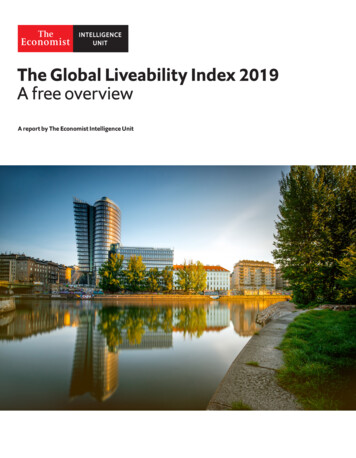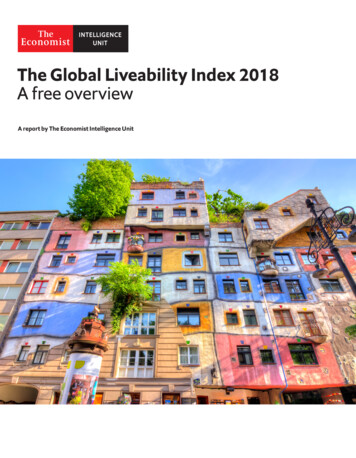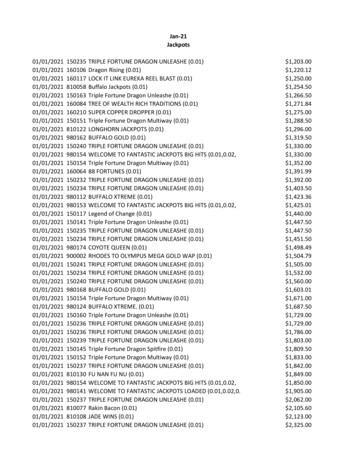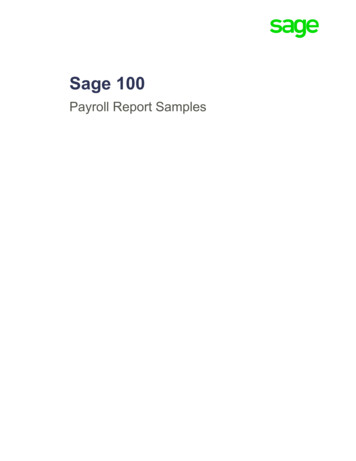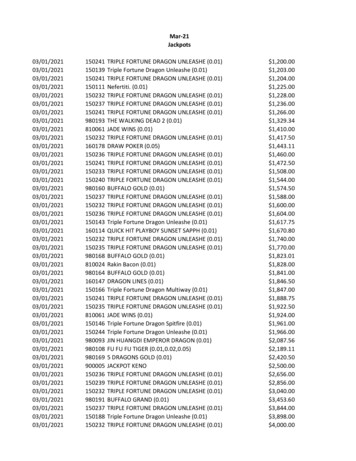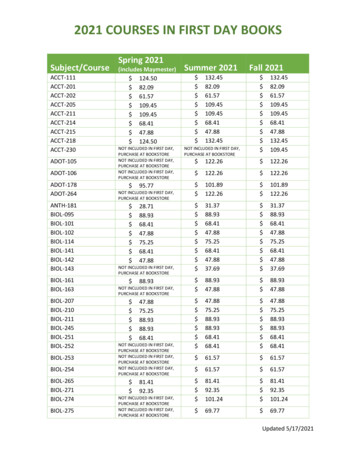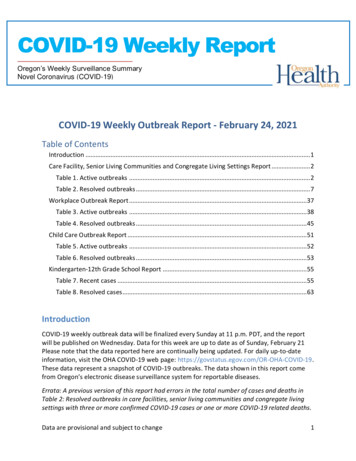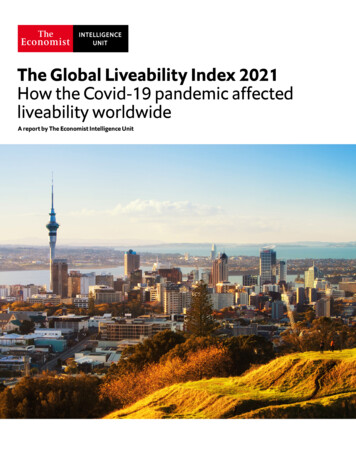
Transcription
The Global Liveability Index 2021How the Covid-19 pandemic affectedliveability worldwideA report by The Economist Intelligence Unit
The world leader in global business intelligenceThe Economist Intelligence Unit (The EIU) is the research and analysis division of The Economist Group, the sister companyto The Economist newspaper. Created in 1946, we have over 70 years’ experience in helping businesses, financial firms andgovernments to understand how the world is changing and how that creates opportunities to be seized and risks to be managed.Given that many of the issues facing the world have an international (if not global) dimension, The EIU is ideally positioned to becommentator, interpreter and forecaster on the phenomenon of globalisation as it gathers pace and impact.EIU subscription servicesThe world’s leading organisations rely on our subscription services for data, analysis and forecasts to keep them informed aboutwhat is happening around the world. We specialise in: Country Analysis: Access to regular, detailed country-specific economic and political forecasts, as well as assessments ofthe business and regulatory environments in different markets. Risk Analysis: Our risk services identify actual and potential threats around the world and help our clients understand theimplications for their organisations. Industry Analysis: Five year forecasts, analysis of key themes and news analysis for six key industries in 60 majoreconomies. These forecasts are based on the latest data and in-depth analysis of industry trends.EIU ConsultingEIU Consulting is a bespoke service designed to provide solutions specific to our customers’ needs. We specialise in these keysectors: Healthcare: Together with our two specialised consultancies, Bazian and Clearstate, The EIU helps healthcareorganisations build and maintain successful and sustainable businesses across the healthcare ecosystem.Find out more at: eiu.com/healthcare Public Policy: Trusted by the sector’s most influential stakeholders, our global public policy practice provides evidencebased research for policy-makers and stakeholders seeking clear and measurable outcomes.Find out more at: eiu.com/publicpolicyThe Economist Corporate NetworkThe Economist Corporate Network (ECN) is The Economist Group’s advisory service for organisational leaders seeking to betterunderstand the economic and business environments of global markets. Delivering independent, thought-provoking content,ECN provides clients with the knowledge, insight, and interaction that support better-informed strategies and decisions.The Network is part of The Economist Intelligence Unit and is led by experts with in-depth understanding of the geographies andmarkets they oversee. The Network’s membership-based operations cover Asia-Pacific, the Middle East, and Africa. Through adistinctive blend of interactive conferences, specially designed events, C-suite discussions, member briefings, and high-calibreresearch, The Economist Corporate Network delivers a range of macro (global, regional, national, and territorial) as well asindustry-focused analysis on prevailing conditions and forecast trends.
THE GLOBAL LIVEABILITY INDEX 2021How the Covid-19 pandemic affectedliveability worldwideData for this survey was collected from February 22nd to March 21st 2021. Key findings include thefollowing: The overall global average liveability score has fallen by seven points, as compared with the averagepre-pandemic score. The extent to which cities were sheltered by strong border closures, theirability to handle the health crisis and the pace at which they rolled out vaccination campaigns drovesignificant changes in the rankings. Auckland, in New Zealand, is at the top of The Economist Intelligence Unit’s Liveability rankings,owing to the city’s ability to contain the coronavirus (Covid-19) pandemic faster and thus liftrestrictions earlier, unlike others around the world. Six of the top ten cities in the March 2021 survey are in New Zealand or Australia, where tight bordercontrols have allowed residents to live relatively normal lives. Many European and Canadian cities have fallen down the rankings, having battled a second Covid-19wave by restricting cultural and sporting events, and closing schools and restaurants. The lower end of the rankings has seen less change, with the Syrian capital, Damascus, still the leastliveable city in the world. Healthcare scores fell after the onset of the pandemic in most cities across the world, with the leastaffected cities concentrated in western Europe and the Asia-Pacific region.Lockdowns affect the most liveable citiesThe pandemic has caused huge volatility in our bi-annual Liveability index, which ranks 140 cities acrossfive areas: stability, healthcare, education, culture and environment, and infrastructure. (For a fullmethodology, see page 6.) Data for this survey were gathered between February 22nd and March 21st2021, when cities were at different stages of their battle with the pandemic.The new leader is Auckland. Owing to border closures and a consequently low Covid-19 case count,New Zealand has been able to keep its theatres, restaurants and other cultural attractions open.Students have been able to continue going to school, giving Auckland a 100% score for education.This has allowed the city to move up from sixth place in our autumn 2020 survey to first position in ourMarch 2021 rankings. The New Zealand capital, Wellington, has also gained from this relative freedom,moving from 15th to joint fourth place in our current rankings.Japanese cities of Osaka and Tokyo ranked second and fourth, respectively, owing to continued highstability scores. In third place is Adelaide in Australia, which also imposed a ban on international travel.Three more Australian cities—Perth, Melbourne and Brisbane—appear in the top ten, with Sydney in11th place. The Swiss cities of Zurich and Geneva also maintained their places in the top ten, despitesome social restrictions still being in place.1 The Economist Intelligence Unit Limited 2021
THE GLOBAL LIVEABILITY INDEX 2021Ten of the most liveable cities in the re & EnvironmentEducationInfrastructureAucklandNew 00.096.4WellingtonNew 92.495100.085.9100.085.7Source: The Economist Intelligence UnitEuropean cities slump as US cities riseFurther down the rankings, the picture is grimmer, particularly in Europe. Vienna, capital of Austria,occupied the top spot throughout 2018-20 but has slipped down to 12th place for the current survey,following the second Covid-19 wave. In Germany, Frankfurt, Hamburg and Dusseldorf have seenthe biggest falls in ranking of all our 140 cities. Canadian cities such as Montreal, Vancouver, Calgaryand Toronto, which have previously scored highly, have also slipped. The downward movement inrankings for the European and Canadian cities can be attributed to the heightened stress on healthcareresources during the second wave of the pandemic.However, several US cities, including Honolulu and Houston, the biggest gainers in the latest survey,have bounced up the rankings over the past six months as social restrictions have lifted.Conditions have not improved in the least liveable citiesWhile the top end of the liveability rankings is volatile, there are few changes at the bottom. As inprevious surveys, living conditions remain worst in Damascus. Also scraping along the bottom areLagos in Nigeria; Port Moresby, the capital of Papua New Guinea; and Dhaka, the capital of Bangladesh.Biggest movers up the ranking in the past six monthsCityLocationIndexRankRank moveIndex bourneAustralia92.58165.0Source: The Economist Intelligence Unit2 The Economist Intelligence Unit Limited 2021
THE GLOBAL LIVEABILITY INDEX 2021Biggest movers down the ranking in the past six monthsCityLocationIndexRankRank moveIndex h y77.357-21-6.5NouméaNew 9-6.0Source: The Economist Intelligence UnitThese continue to score poorly across the five categories. A consistently low stability score, owing toongoing civil unrest and military conflicts, is the reason behind most of these cities featuring in thebottom ten. However, conditions have deteriorated even further as a result of Covid-19—particularlyfor healthcare.Healthcare scores have fallen sharplyUnsurprisingly, the healthcare scores in our rankings were affected badly by the pandemic. Comparedwith six months ago, the average city score for healthcare has dropped by nearly five points.Healthcare conditions have worsened markedly in Prague (Czech Republic), Athens (Greece) andJakarta (Indonesia), where the Covid-19 case count was rising at the time of the survey. This addedstress on the healthcare sector, making it more difficult to get a hospital bed and access to qualityhealthcare services.Ten of the least liveable cities in the re & 833.326.8Port .825.032.1Source: The Economist Intelligence Unit3 The Economist Intelligence Unit Limited 2021
THE GLOBAL LIVEABILITY INDEX 2021By contrast, the US city of Honolulu witnessed a rise in its healthcare score of 33 points comparedwith the previous survey. Over half of Hawaii’s residents have now received at least one dose ofa vaccine. Positivity rates have also reduced, thereby imposing a much lower stress on the city’shealthcare infrastructure. The Spanish cities of Barcelona and Madrid (capital) gained nearly 25 pointsfor healthcare, as they coped better in terms of the stress on their healthcare systems compared withthe previous wave of Covid-19.In the latest survey, we introduce new metrics scoring cities on their responses to Covid-19, as well asaccess to healthcare and the quality of care received. The subscription version of the liveability rankingsalso contains some additional scores on Covid-19 vaccination rates, case rates and death rates.Culture and environment have been affectedSince the pandemic started, curbs on public gatherings have also had a major impact on scores underthe culture and environment category. The average score for this category fell by 14 points comparedwith the autumn 2019 survey.Some of the social and cultural restrictions have been lifted since September 2020 in some parts ofthe world. New Zealand and Australian cities have benefited the most from this trend, as have citiesin the US and China. When, in March 2021, Texas became one of the first US states to lift restrictionson public spaces, Houston became the only US city to enter our top ten for culture and environmentconditions. European cities such as Copenhagen, Zurich and Geneva also feature among the top ten,having eased restrictions on outdoor gatherings.Little change in other categoriesreen Cvir ulton urem &entEducationInfrastructurecaalthHeOvin eralde lxStabilityStability, education and infrastructure have seen little change in their overall scores from six monthsago; education is still lagging behind its pre-pandemic scores. Australia and New Zealand nowdominate the top of the education rankings.Elsewhere, however, there are still intermittentHealthcare average fell sharply;school closures in many cities, forcing pupilsinfrastructure remained flatto rely on online learning. Infrastructure,(change in average over the past six months)2 including transport, has been protected in many1 geographies by public funding.Stability scores, meanwhile, have deteriorated0in some Middle-Eastern locations since before-1 the pandemic, but generally remain stable. Across-2 the world, there have been protests over issuessuch as civil liberties, racism, legislation and living-3standards over the past six months. In many cities,-4 increased government subsidies and restrictions-5 on public gatherings have reduced visiblesocial unrest.Source: The Economist Intelligence Unit.4 The Economist Intelligence Unit Limited 2021
THE GLOBAL LIVEABILITY INDEX 2021Covid-19 will continue to affect city liveabilityVaccination campaigns are now under way, at varying levels of efficiency, across the world. So, whatchanges should we expect in our next survey? Conditions in the poorest cities are likely to deterioratefurther, should cities fail to get the vaccines they need to prevent the spread of new Covid-19 variants.Weak healthcare systems could come under greater strain, as they have in India. A slower inoculationdrive would result in a more strict lockdown, thereby affecting the expected recovery in economicgrowth. This, in turn, could affect other categories, including stability.The pace of recovery of liveability in most regions will be determined by how effectively the healthrisks of the pandemic can be controlled, through a combination of vaccination, testing, tracing andquarantine measures. Barring huge setbacks, such as the emergence of vaccine-resistant variants,scores for culture and environment should improve. Schools should begin to return to normality.However, healthcare systems will remain under pressure as they attempt to catch up with a backlog ofnon-Covid care cases. Moreover, what residents value in their cities may also have changed, with greenspaces becoming more popular and public transport less so than before the pandemic.5 The Economist Intelligence Unit Limited 2021
THE GLOBAL LIVEABILITY INDEX 2021About The Economist Intelligence Unit’sliveability surveyHow the rating worksThe concept of liveability is simple: it assesses which locations around the world provide the best andworst living conditions. Assessing liveability has a broad range of uses, from benchmarking perceptionsof development levels to assigning a hardship allowance as part of expatriate relocation packages.City officials and urban policymakers can use the rankings to benchmark target cities against thetop-ranked cities. The ratings can help them to understand the gap between target cities and the bestranked cities across different categories. This in turn should help to frame policies and target investors.The Economist Intelligence Unit’s liveability rating quantifies the challenges that might be presented toan individual’s lifestyle in any given location and allows for direct comparison between locations.Every city is assigned a rating for relative comfort for over 30 qualitative and quantitativefactors across five broad categories: stability, healthcare, culture and environment, education andinfrastructure. Each factor in a city is rated as acceptable, tolerable, uncomfortable, undesirable orintolerable. For qualitative indicators, a rating is awarded based on the judgment of our team of expertanalysts and in-city contributors. For quantitative indicators, a rating is calculated based on the relativeperformance of a number of external data points.The Covid-19 pandemic has affected living conditions in many cities, owing to its impact on thehealthcare infrastructure, and restrictions and lockdown measures imposed by governments, whichhave put the healthcare, culture and environment, and education categories under stress. The impactof the pandemic has been incorporated into our overall liveability score, with the introduction of newindicators to assess these stress and restriction levels for each city. Stress on healthcare resources Restrictions on local sporting events Restrictions on theatre Restrictions on classic and modern music concerts Restrictions on restaurants, bars, coffee shops and nightclubs Restrictions on educational institutesThe scores for these new indicators and its effect are incorporated in our existing healthcare, cultureand environment and education ratings.The scores are then compiled and weighted to provide a score in the range 1-100, where 1 isconsidered intolerable and 100 is considered ideal. The liveability rating is provided both as an overallscore and as a score for each category. To provide points of reference, the score is also given foreach category relative to a control city (New York) and an overall position in the ranking of 140 citiesis provided.6 The Economist Intelligence Unit Limited 2021
THE GLOBAL LIVEABILITY INDEX 2021The suggested liveability scaleCompanies pay a premium (usually a percentage of a salary) to employees who move to cities whereliving conditions are particularly difficult, such as excessive physical hardship or a notably unhealthyenvironment.The Economist Intelligence Unit has given a suggested allowance to correspond with the rating.However, the actual level of the allowance is often a matter of company policy. It is not uncommon, forexample, for companies to pay higher allowances—perhaps up to double The Economist IntelligenceUnit’s suggested level.Rating descriptionSuggested allowance (%)80-100 There are few, if any, challenges to living standards 070-80 Day-to-day living is fine, in general, but some aspects of life may entailproblems 560-70 Negative factors have an impact on day-to-day living 1050-60 Liveability is substantially constrained 1550 or less Most aspects of living are severely restricted 20How the rating is calculatedThe liveability score is reached through category weights, which are divided equally into relevantsubcategories to ensure that the score covers as many indicators as possible. Indicators are scored asacceptable, tolerable, uncomfortable, undesirable or intolerable. These are then weighted to produce arating, where 100 indicates that liveability in a city is ideal and 1 means that it is intolerable.For qualitative variables, an “EIU rating” is awarded based on the judgment of in-house expertgeography analysts and a field correspondent based in each city. For quantitative variables, a rating iscalculated based on the relative performance of a location using external data.Category 1: Stability (weight: 25% of total)7IndicatorSourcePrevalence of petty crimeEIU ratingPrevalence of violent crimeEIU ratingThreat of terrorEIU ratingThreat of military conflictEIU ratingThreat of civil unrest/conflictEIU rating The Economist Intelligence Unit Limited 2021
THE GLOBAL LIVEABILITY INDEX 2021Category 2: Healthcare (weight: 20% of total)IndicatorSourceAvailability of private healthcareEIU ratingQuality of private healthcareEIU ratingAvailability of public healthcareEIU ratingQuality of public healthcareEIU ratingAvailability of over-the-counter drugsEIU ratingGeneral healthcare indicatorsAdapted from World BankCategory 3: Culture & Environment (weight: 25% of total)IndicatorSourceHumidity/temperature ratingAdapted from average weather conditionsDiscomfort of climate for travellersEIU ratingLevel of corruptionAdapted from Transparency InternationalSocial or religious restrictionsEIU ratingLevel of censorshipEIU ratingSporting availabilityEIU field rating of 3 sport indicatorsCultural availabilityEIU field rating of 4 cultural indicatorsFood and drinkEIU field rating of 4 cultural indicatorsConsumer goods and servicesEIU rating of product availabilityCategory 4: Education (weight: 10% of total)IndicatorSourceAvailability of private educationEIU ratingQuality of private educationEIU ratingPublic education indicatorsAdapted from World BankCategory 5: Infrastructure (weight: 20% of total)8IndicatorSourceQuality of road networkEIU ratingQuality of public transportEIU ratingQuality of international linksEIU ratingAvailability of good-quality housingEIU ratingQuality of energy provisionEIU ratingQuality of water provisionEIU ratingQuality of telecommunicationsEIU rating The Economist Intelligence Unit Limited 2021
Global Liveability ProductsLiveability Ranking and OverviewA complete overview of the challenges to an individual’s lifestyle in 140 cities worldwide. View liveabilityrankings and average scores for all cities across five broad categories: stability, healthcare, culture andenvironment, education and infrastructure.What’s included? The EIU’s liveability rankings for 140 cities. Overall liveability average scores for all cities in 5 categories: stability, healthcare, culture andenvironment, education and infrastructure. A summary of findings and a description of the methodology used.Find out more at the EIU Store.Global Liveability surveyThe liveability survey appraises 140 cities through their individual city profiles to review regional trends,and quantify the challenges to an individual’s lifestyle there.What’s included? The EIU’s liveability rankings for 140 cities. Overall liveability average scores for all cities in 5 categories: stability, healthcare, culture andenvironment, education and infrastructure. Individual city profiles for each city within the survey.Find out more at the EIU Store.Global Liveability matrixBuild your own models with this dataset ranking the challenges to an individual’s lifestyle in 140 citiesworldwide, and evaluate key trends that might affect the development of cities in the future.What’s included? The EIU’s liveability rankings for 140 cities. Overall liveability average scores for all cities in 5 categories: stability, healthcare, culture andenvironment, education and infrastructure. Interactive dataset that ranks cities in over 30 qualitative and quantitative factors.Find out more at the EIU Store.9 The Economist Intelligence Unit Limited 2021
Copyright 2021 The Economist Intelligence Unit Limited. Allrights reserved. Neither this publication nor any partof it may be reproduced, stored in a retrieval system, ortransmitted in any form or by any means, electronic,mechanical, photocopying, recording or otherwise,without the prior permission of The EconomistIntelligence Unit Limited.While every effort has been taken to verify theaccuracy of this information, The EconomistIntelligence Unit Ltd. cannot accept anyresponsibility or liability for reliance by any personon this report or any of the information, opinionsor conclusions set out in this report.Cover image - Nazar Abbas Photography/Getty Images
LONDONThe Economist Intelligence Unit20 Cabot SquareLondon E14 4QWUnited KingdomTel: 44 (0) 20 7576 8181Email: london@eiu.comGURGAONThe Economist Intelligence UnitSkootr Spaces, Unit No. 1,12th Floor, Tower B, Building No. 9DLF Cyber City,Phase – IIIGurgaon – 122002HaryanaIndiaTel: 91 124 6409486Email: asia@eiu.comNEW YORKThe Economist Intelligence UnitThe Economist Group750 Third Avenue 5th FloorNew York, NY 10017,United StatesTel: 1 212 698 9717Email: americas@eiu.comHONG KONGThe Economist Intelligence Unit1301 Cityplaza Four12 Taikoo Wan RoadTaikoo ShingHong KongTel: 852 2802 7288Email: asia@eiu.comDUBAIThe Economist Intelligence UnitPO Box No - 450056Office No - 1301AAurora TowerDubai Media CityDubaiUnited Arab EmiratesTel 971 4 4463 147email: mea@eiu.com
The Economist Intelligence Unit (The EIU) is the research and analysis division of The Economist Group, the sister company to The Economist newspaper. Created in 1946, we h ave over 70 year

